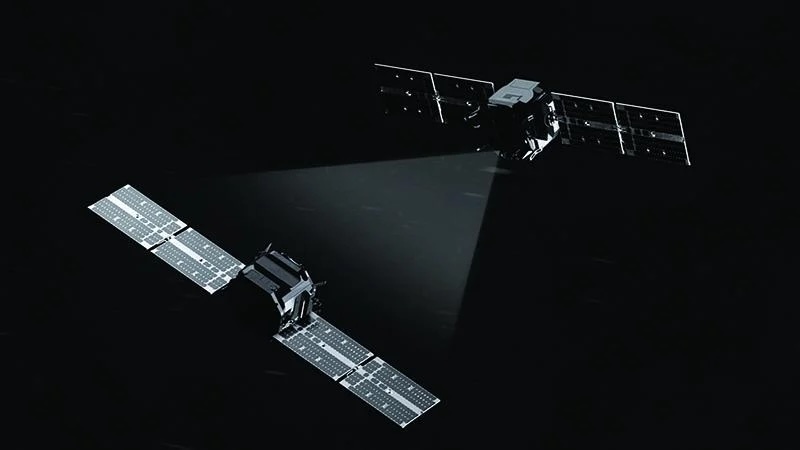7.08.2025

True Anomaly is providing its Jackal autonomous space vehicle for the Space Force’s Victus Haze mission.
With space as the ultimate high ground, the U.S. is honing its ability to launch with little warning and adapt quickly to deter threats before they materialize.
The U.S. military has realized that patience is no virtue as it prepares for future conflict in space. To address the urgency to be able to respond to threats quickly, the Pentagon has launched the Tactically Responsive Space (TacRS), an ambitious effort to make launch on demand a normal part of U.S. Space Force operations.
- Upcoming mission is slated to feature on-orbit maneuvering and domain awareness
- The Space Force is planning at least three more “Victus” initiatives
For decades, the Pentagon treated space systems built for intelligence-gathering and satellite communications as largely safe from attack as they enabled other service operations. In that environment, multiyear contracts to build new spacecraft and lengthy launch campaigns were deemed acceptable.
But in an era when potential threats can move at orbital speeds, the service is feeling pressured to respond quickly and flexibly when an adversary launches a novel space object, or when a malfunctioning or disabled satellite needs replacement.
The Space Force achieved what many considered an improbable goal on Sept. 14, 2023: taking a commercially built satellite from contract to launch-ready in less than a year, followed by liftoff within 27 hr. of a call-up. The mission, called Victus Nox—Latin for “conquer the night”—improved on the results of a 2021 effort in which the service deployed a space domain awareness satellite to low Earth orbit (LEO) in a then-unprecedented 21 days.

Chief of Space Operations Gen. Chance Saltzman has likened the success of Victus Nox to Chuck Yeager’s breaking of the sound barrier in 1947 and says the achievement has significant implications for how the Space Force responds to future threats. “Now the question is: ‘How do we take advantage of that?’” he said during a virtual event in October 2023.
The service is planning several TacRS missions over the next two years to provide real-world data for responsive launch concepts, focusing heavily on space domain awareness to avoid on-orbit surprises (see graphic below). While Victus Nox sought to compress the typical multiyear process to launch and deploy a spacecraft into a matter of months, the next mission will incorporate the high-stakes capability of maneuvering satellites near others for inspection or surveillance.
Victus Haze is slated to take place between the end of 2025 and early 2026. The Space Force has tasked two industry groups to perform red and blue team demonstrations of rendezvous and proximity operations (RPO) and space domain awareness.
As part of one team, space defense technology company True Anomaly is building its Jackal autonomous orbital vehicle and an undisclosed payload to be launched on a Firefly Aerospace Alpha small-lift launch vehicle from Vandenberg SFB, California. In parallel, Rocket Lab is supplying a spacecraft from its Pioneer production line as well as its Electron small-lift rocket to launch from the company’s facilities in Mahia, New Zealand, carrying a multi-aperture optical telescope built by Lawrence Livermore National Laboratory (LLNL).
With Victus Haze, the Space Force wants to take the lessons learned from the 2023 mission and see what happens when the whole technology stack is commercialized, Col. Bryon McClain, program executive officer for space domain awareness and combat power, said at the annual Space Symposium in Colorado Springs in April.
The ability to launch on demand rests on the innovation that companies such as Firefly, Rocket Lab and True Anomaly have brought to the space ecosystem by mass-producing satellites and rockets for faster integration and deployment.
Firefly is scaling up its Alpha rocket production and has eight launches on its 2026 manifest. The company has also invested in a dedicated payload processing facility to streamline bottlenecks exposed during Victus Nox, in which it launched a satellite built by Boeing subsidiary Millennium Space Systems from Vandenberg SFB.
The challenges during that mission were bureaucratic rather than technical, says Jason Kim, who was CEO of Millennium during Victus Nox and left to lead Firefly less than one year later. Streamlining processes like cybersecurity approvals proved just as important as launch readiness, he says.
The Space Force has incorporated lessons from Victus Nox to boost its launch tempo at Vandenberg SFB. Space Launch Delta (SLD) 30, the unit responsible for launch operations from the Western Range, oversaw 51 launches in 2024—up from just six in 2023—and is on track to beat that record this year.
While a surge in SpaceX flights last year drove the increase, the TacRS mission was a critical exercise in “cutting fat” from regular activities, leading to more launch opportunities, Col. Mark Shoemaker, then-SLD 30 commander, told reporters in January at a conference in Orlando, Florida.
“What Victus Nox allowed us to do is go, ‘Well, we can do that. Why don’t we just do that every day?’” he said. Shoemaker retired on July 3.

Rocket Lab has already shown that it can launch on tight timelines. The company launched two missions within 48 hr. in June from its facilities in New Zealand. It pulled off two launches in less than 24 hr. from two separate sites last year.
The company has built its business model around an integrated space offering, from satellite systems and payloads to launch and ground stations. This makes the Victus Haze mission an easy fit, says Richard French, vice president of business development and strategy for space systems. Bringing the company’s New Zealand launchpad into the TacRS mix offers “multidimensional resilience,” he adds.
Supply chain changes are key to the pace of operations, too. Space telescopes used to be tailor-made and delicate to assemble. LLNL has refined its optics technology to build shelf-stable telescopes that are well-suited for responsive space missions. In addition, the facility has partnered with telescope manufacturer Starris: Optimax Space Systems to commercialize and scale its patented technology specifically for space domain awareness missions. LLNL has flown monolith telescope imaging missions on five different satellites in the past five years, including the 2021 responsive demonstration.
While TacRS seeks to address the modern space threat environment, the idea of rapidly deployable space assets is not new. LLNL traces its responsive space mission heritage to the Strategic Defense Initiative, when it built interceptor vehicles and their sensor systems under the Brilliant Pebbles program (AW&ST June 13, 1988, p. 151). When NASA’s Clementine mission launched in 1994—the first U.S. spacecraft launched to the Moon in more than 20 years—it carried optical sensors developed for Brilliant Pebbles, which provided the first complete look at the lunar surface, including the poles (AW&ST July 18, 1994, p. 68).
In the wake of the Sept. 11, 2001, terrorist attacks, the U.S. began to recognize that traditional space systems were too slow and inflexible to respond to increasingly dynamic situations. But a tactically responsive capability was “a concept ahead of its time,” says Stephen Kitay, a former Pentagon official who is now senior vice president of space defense at True Anomaly.
That has changed. The big shift is a “full-stack technology approach” coming out of commercial space companies, Kitay says. The approach incorporates launch vehicles designed to integrate and deploy payloads into orbit very quickly, satellites that are mass-produced at lower costs and flexible ground systems.
The ability to loft a new spacecraft to replace a malfunctioning system—or one taken offline by an adversary—has obvious benefits. But the Pentagon is particularly keen to use a rapid-launch capability to improve its knowledge of what is going on in space.
The growing sophistication of foreign systems, particularly from China and Russia, has rendered the space domain awareness mission essential for the U.S. military. When adversaries launch new systems, it is “fundamentally hard to know what is what,” LLNL Space Program Leader Ben Bahney says. Responsive imaging missions “allow us to go and find out,” he adds, calling space domain awareness the ideal mission set for TacRS.
At least three more missions are in the pipeline. Two follow-ons, Victus Surgo and Victus Salo, will explore how maneuverable satellites and prepositioned assets can reduce the need for last-minute launches. McClain likened the missions’ goals to placing a sophisticated traffic camera above a highway overpass.
The Space Force awarded orbital transportation startup Impulse Space a $34.5 million contract in October to build two maneuverable satellites and procure commercial rideshare slots, with expected launches in the fall of 2026. Under Victus Surgo, the spacecraft are to carry an Optimum Technologies optical payload into a geosynchronous transfer orbit, while Victus Salo is to deploy a sensor built by the Massachusetts Institute of Technology’s Lincoln Laboratory to LEO, a service spokesperson says.
The Space Force hopes to achieve that “next evolution” of an operationalized TacRS mission by next spring, Lt. Gen. DeAnna Burt, deputy chief of space operations for operations, cyber and nuclear capabilities, said in an August webinar. Once that happens, combatant commanders can trust that, when the need arises, they can call up a pre-staged satellite for launch “as they see fit,” she said.
The Space Force is preparing to take the TacRS capability beyond the trial phase. With Victus Sol, the service will use a Firefly Alpha rocket to launch an undisclosed spacecraft for an operational mission. Like Victus Nox, it will launch only upon senior leadership call-up.
It will not be the last. The Space Force is considering additional RPO and pre-positioned missions.
For McClain, TacRS is no longer just a technology demonstration, but a blueprint for the Space Force’s future. In the long term,, “absolutely, this is an operational capability,” he said at the conference in April.
Quelle: AVIATION WEEK
